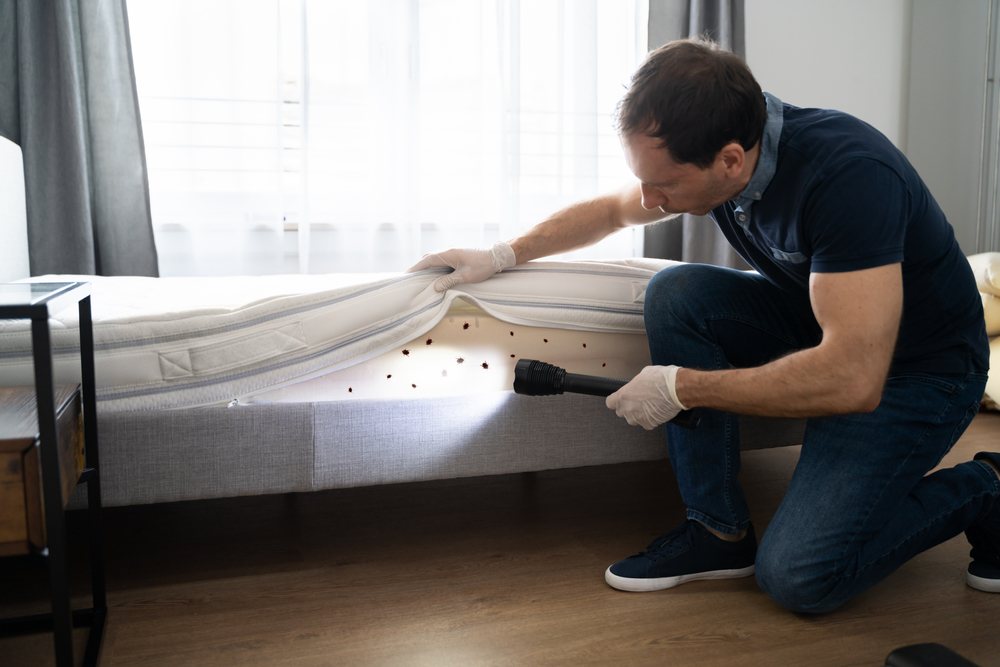Have you been traveling recently?
Noticed any irritating bug bites afterward?
This could be a sign of a looming bed bug infestation…
But it could also be a sign of ticks, too.
Unfortunately, either one is bad news. Bed bugs can cause physical, mental and financial stress because of their ability to spread and general resilience to household pesticides.
Ticks on the other hand, are dangerous and can carry a variety of diseases.
So, how do you tell a bed bug apart from a tick?
Despite the similarities in their behavior, bed bugs and ticks are very different creatures.

Once you know what to look for, identifying the differences becomes rather easy.
On that note.. Let’s dive in.
Page Contents:
Can Ticks be Mistaken for Bed Bugs?
At a quick glance, ticks and bed bugs are indistinguishable. Both of these bugs share physical similarities, despite being a part of a totally different species.
Both insects are also fairly small.
An adult bed bug averages around ¼ of an inch in length, roughly the size of a seed.
Ticks are even smaller, with adults being less than an ⅛ of an inch long.
Bed bugs and ticks also have similarly shaped bodies. They both possess flat torsos that keep them close to the ground. Because of this, neither species can move fast and are incapable of jumping or flying.

Both creatures are also considered parasites. This means that they rely on a host for food (or in this case blood).
However, there is an important difference in their feeding habits…
Bed bugs feed exclusively off of human blood, whereas Ticks mainly drink animal blood, and only feed on humans if their usual hosts aren’t available.
Do Bed Bugs Bite Like Ticks?
One of the key differences between bed bugs and ticks is how they bite. In fact, the manner in which they bite can be a key method for proper identification.
Bed bug bites look like red-colored welts. They are most commonly found on the upper torso, including the neck, face and arms.
Bite marks will also be clustered together or form a zig-zag pattern.

A tick bite looks like a single, large rash. The bite will also exhibit a distinct bullseye-like appearance.
Tick bites can be found anywhere on the body. While they are more commonly found on the lower torso, bite marks can also occur on the scalp or the back of the neck.
How Do You Tell If It’s a Tick or a Bed Bug?
Aside from their unique bites, there are other ways to tell a bed bug apart from a tick.
Let’s go through 5 additional ways to tell these two creatures apart:
1. Legs: Bed bugs, like all insects, only have 6 legs. While ticks may look like insects, they are actually arachnids. This means that they have 8 legs.
2. Mouth: It’s hard to see with the naked eye, but looking at an up-close picture will reveal the difference between a bed bug’s mouth and a tick’s mouth. Bed bugs have mouth parts designed to saw through the skin & suck out the blood. A tick’s mouth is beak-like, meant for latching onto a host.
3. Color: A bed bug has reddish-brown skin. After a feeding, they will appear bright red due to the undigested blood in their system. Ticks have lighter skin, and may have dark stripes on their legs or torso.
4. Numbers: The phrase “where there’s one, there’s a thousand” holds true for bed bugs. Females will lay roughly 500 eggs in their lifetime, meaning a bed bug colony will develop rather quickly. While ticks aren’t entirely solitary, they don’t form large groups either. Even if you have multiple tick bites, chances are you’re only dealing with a small handful of individual ticks.
5. Location: Bed bugs are a household pest. Because they subsist off of human blood, they build their colonies in houses, apartments and hotels. Ticks, on the other hand, live in wooded areas or in places with tall grass.
Are Ticks Found in Beds?
Unlike bed bugs, ticks aren’t really an “indoor” pest. They are found in nature, especially in wooded or grassy areas.
If a tick does find its way indoors, it will be because of its host. Ticks have evolved to “burrow” into the skin of the animal they’re feeding on. So, if a tick latches onto a human or a household pet, it will inevitably be brought into the home.

And it won’t take long for a tick to adjust to this new, indoor environment…
Beds and bedding materials are a perfect place for ticks to hide. They are very small, allowing them to slip into various nooks and crannies. These remote places also provide a convenient place for ticks to lay their eggs.
By hiding in a bed, ticks will also have regular access to food. Once a human is fast asleep, they’ll come crawling out to have a drink of blood.
What Do Ticks Hate?
If you live in an area where ticks are common, you’ll want to do everything you can to repel them. There are plenty of natural methods that are both cost-efficient and safe to use around your house.
For starters, ticks hate the scent of vinegar.
Vinegar is an acetic acid, meaning it has mild corrosive properties. While this corrosion has next to no impact on humans, it has an enormous impact on ticks.
When a tick is exposed to vinegar, the scent attacks its nervous system and disorients the insect. It also corrodes certain chemicals protecting the exoskeleton, essentially dehydrating it.
For similar reasons, ticks are repelled by certain fruits and vegetables.
Garlic, onions, and citrus fruits like lemons all contain chemical compounds that give them their trademark scent. When exposed to these objects, ticks will begin to suffocate and attempt to flee the area.
You can also keep ticks away through a daily household item like lavender.

Lavender naturally contains a chemical called linalool, which is also found in things like mint or cinnamon. Many chemical pesticides use linalool as an ingredient, hence why it’s so effective against ticks.
These items aren’t just effective on ticks. Bed bugs also hate these things!
What Instantly Kills Ticks?
Ticks are hardy little creatures. Like many bugs, they can be easily repelled but are hard to properly kill.
Whether you’re dealing with one tick or several, here are the best methods to use when exterminating them:
Diatomaceous earth: This is a powdery substance commonly used to kill pests like spiders, ants and bed bugs. When a tick crawls through the powder, the shards will embed themselves in the tick’s exoskeleton and slowly dissolve it.
Expert Tip – Sprinkle it in nooks or dark crevices where you believe pests are hiding to ensure they are properly exposed to the powder.
Heat treatment: This method is useful if ticks are stuck to your clothing or bedding material. Simply toss everything in the dryer (no need to wash the laundry beforehand) and put the heat to a high setting. Any ticks exposed to the heat will die in a matter of minutes.
Pesticides: If you spot any ticks outside, spraying a chemical pesticide will kill them instantly. Some sprays are designed to kill adult ticks, while others are for nymphs and larvae. Be sure to take caution when using these around small children or pets.
Summary
The below table highlights the key differences between ticks and bed bugs.
| Bed Bugs | Ticks |
|---|---|
| Size – 1/4 Inch long | Size – 1/8 inch long |
| Bed bugs do not cause disease | Ticks can transmit Lyme Disease. Anaplasmosis. And more |
| Bites mostly the upper body | Bites primarily the lower body |
| Bed bug bites look like red-colored welts | A tick bite looks like a single, large rash |
| Bed bugs have 6 legs | Ticks have 8 Legs |
| Color – reddish brown | Color – light brown or translucent |
| Bed bugs are often found in colonies. | Ticks aren’t entirely solitary but do not form large groups. |
| Bed bugs are a household pest. | Ticks are commonly found outdoors wooded areas. |




